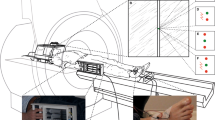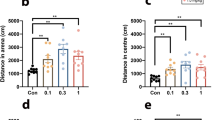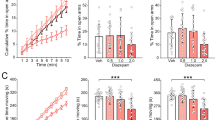Abstract
Rationale: Compounds varying in selectivity as 5-HT1A receptor antagonists have recently been reported to produce anxiolytic-like effects comparable to those of benzodiazepines in the mouse elevated plus-maze procedure. Objective: In view of the potential clinical significance of these findings, the present experiments compared the behavioural effects of diazepam (0.5–3.0 mg/kg) with those of several non-selective 5-HT1A receptor antagonists [NAN-190, 0.1–3.0 mg/kg, MM-77, 0.03–1.0 mg/kg, (S)-UH-301, 0.3–3.0 mg/kg and pindobind-5-HT1A, 0.03–1.0 mg/kg], and three selective 5-HT1A receptor antagonists (WAY100635, 0.01–3.0 mg/kg, p-MPPI, 0.1–3.0 mg/kg and SL88.0338, 0.3–3.0 mg/kg) in the mouse defence test battery (MDTB). Methods: In this well-validated anxiolytic screening test, Swiss mice are directly confronted with a natural threat (a rat) as well as situations associated with this threat. Primary measures taken during and after rat confrontation were flight, risk assessment (RA), defensive threat/attack and escape attempts. Results: Diazepam significantly decreased flight reactions after the rat was introduced into the runway, reduced RA activities of mice chased by the rat, increased RA responses displayed when subjects were constrained in a straight alley and reduced defensive upright postures and biting upon forced contact. All the selective 5-HT1A receptor antagonists and NAN-190 also reduced flight, RA in the chase test, and defensive threat and attack behaviours. (S)-UH-301 and pindobind-5-HT1A reduced RA in the chase test, but only partially modified defensive threat and attack. Unlike the other drugs tested, MM-77 produced significant effects only at doses which also markedly reduced spontaneous locomotor activity, suggesting a behaviourally non-specific action. In contrast to diazepam, the 5-HT1A receptor ligands failed to affect RA in the straight alley test. Following removal of the rat from the test area, only diazepam and (S)-UH-301 reduced escape behaviour (contextual defence) at doses which did not decrease locomotion. Overall, the present findings indicate that except for one RA behaviour and escape responses, the 5-HT1A receptor ligands studied modified the same defensive behaviours as diazepam, suggesting potential therapeutic efficacy in the management of anxiety disorders. However, the magnitude of the effects of the 5-HT1A compounds on defence was generally smaller than that of the benzodiazepine. Conclusion: As all of the 5-HT1A compounds tested in this series share antagonistic activity in models of postsynaptic 5-HT1A receptor function, it is proposed that this action accounts for their effects on defence.
Similar content being viewed by others
Author information
Authors and Affiliations
Additional information
Received: 29 June 1998 / Final version: 16 December 1998
Rights and permissions
About this article
Cite this article
Griebel, G., Rodgers, R., Perrault, G. et al. Behavioural profiles in the mouse defence test battery suggest anxiolytic potential of 5-HT1A receptor antagonists. Psychopharmacology 144, 121–130 (1999). https://doi.org/10.1007/s002130050984
Issue Date:
DOI: https://doi.org/10.1007/s002130050984




